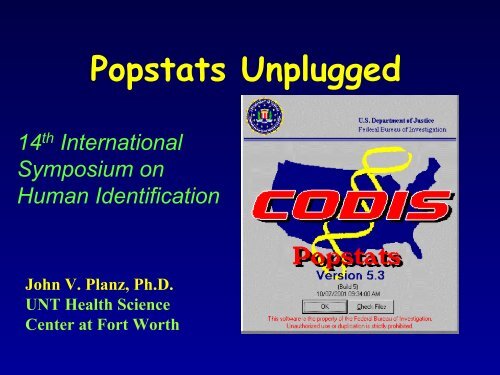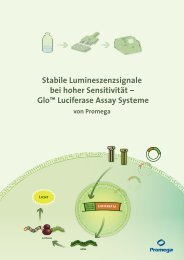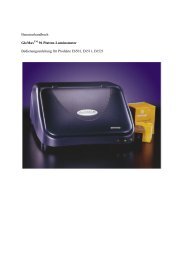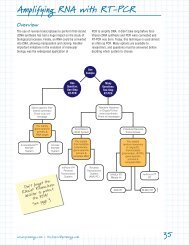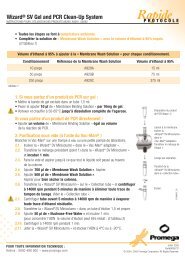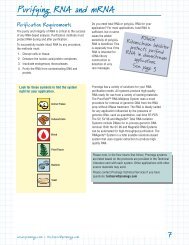Calculation of Mixture Statistics Using Popstats - Promega
Calculation of Mixture Statistics Using Popstats - Promega
Calculation of Mixture Statistics Using Popstats - Promega
You also want an ePaper? Increase the reach of your titles
YUMPU automatically turns print PDFs into web optimized ePapers that Google loves.
<strong>Popstats</strong> Unplugged<br />
14 th International<br />
Symposium on<br />
Human Identification<br />
John V. Planz, Ph.D.<br />
UNT Health Science<br />
Center at Fort Worth
<strong>Calculation</strong> <strong>of</strong> <strong>Mixture</strong><br />
<strong>Statistics</strong> using PopStats<br />
What are we asking <strong>Popstats</strong><br />
to provide us??<br />
What do we have to do<br />
before we use <strong>Popstats</strong> ??
What Constitutes a DNA<br />
<strong>Mixture</strong>?<br />
Presence <strong>of</strong> three or more alleles<br />
at several loci typed<br />
Rationale: No more than two alleles can<br />
originate from a single individual (occasional<br />
exceptions do exist – e.g., Tri-allelic TPOX<br />
pr<strong>of</strong>iles in single individuals have been found in<br />
several populations).
What Constitutes a DNA<br />
<strong>Mixture</strong>?<br />
Imbalance <strong>of</strong> Alleles<br />
detected in the sample<br />
Peak height difference, intensity<br />
difference, etc. are caused by differential<br />
amount <strong>of</strong> DNA contributed by different<br />
contributors in a sample.
What Constitutes a DNA<br />
<strong>Mixture</strong>?<br />
Circumstantial Evidence<br />
Search for foreign DNA in intimate samples, in<br />
many cases, may recover traces <strong>of</strong> DNA <strong>of</strong> the<br />
person who is technically a “substrate” even if<br />
attempts to fractionate the DNA are made<br />
during the test… incomplete differential<br />
extracts, penile swabs, etc
Common <strong>Mixture</strong><br />
Interpretations<br />
• Pr<strong>of</strong>iles <strong>of</strong> two or more tested persons explain<br />
all alleles detected in the mixture sample,<br />
<strong>Mixture</strong> contains unexplained alleles beyond<br />
the ones present in the pr<strong>of</strong>iles <strong>of</strong> the known<br />
persons pr<strong>of</strong>iled,<br />
Unknown persons contributed to the<br />
mixture,<br />
Contamination
Common <strong>Mixture</strong><br />
Interpretations<br />
Alleles with low intensity consistently belong to<br />
specific (known or unknown) persons pr<strong>of</strong>iled<br />
(i.e., minor and major contributors in the DNA<br />
mixture).
<strong>Mixture</strong> Interpretation<br />
Alleles that enter into statistical<br />
calculations first meet the<br />
interpretation guidelines for data<br />
analysis<br />
RFU Threshold<br />
Peak ratios/percent stutter<br />
“Match” criteria
But, before we begin…<br />
<strong>Calculation</strong>s based on mixed<br />
pr<strong>of</strong>iles fall under the same<br />
statistical assumptions that we<br />
use in the calculation <strong>of</strong> single<br />
source pr<strong>of</strong>ile statistics
Assumptions<br />
Hardy Weinberg Equilibrium<br />
No allele dropout<br />
Individuals are unrelated<br />
Population substructure is negligible<br />
Contributors are <strong>of</strong> the same race<br />
But also,<br />
unlike conventional frequency<br />
reporting…<br />
We have to address specific hypotheses
Two common questions are generally asked:<br />
How <strong>of</strong>ten would a random person be<br />
excluded as a contributor to the observed<br />
mixture ? (Exclusion Probability)<br />
What statistical support is there for any<br />
postulated hypothesis <strong>of</strong> the origin <strong>of</strong> the<br />
mixture? (Likelihood)
Exclusion Probability<br />
Exclusion probability addresses<br />
the question:<br />
How <strong>of</strong>ten a random person<br />
would have been excluded as a<br />
contributor in the observed<br />
DNA mixture?
Exclusion Probability<br />
This is a measure <strong>of</strong> how powerful the<br />
DNA testing panel is in excluding<br />
noncontributory individuals from the<br />
analysis<br />
The statistic is based on the allelic<br />
composition <strong>of</strong> the mixture…not the<br />
pr<strong>of</strong>iles <strong>of</strong> potential contributors
Exclusion Probability<br />
The computation <strong>of</strong> the exclusion<br />
probability is done exactly as in<br />
the parentage testing
For example:<br />
Exclusion Probability<br />
Suppose that the mixture contains<br />
i alleles (A 1 , A 2 , …, A i at a locus),<br />
whose frequencies are<br />
p 1 , p 2 , …, p i, respectively)
Exclusion Probability<br />
Individuals whose genotypes<br />
contain only one or two <strong>of</strong> the i<br />
alleles cannot be excluded as<br />
contributors in this mixture.<br />
To be excluded, the person<br />
should have at least one allele in<br />
his/her genotype not seen in the<br />
mixture.
Exclusion Probability<br />
The probability <strong>of</strong> inclusion is<br />
given by<br />
(p 1 + p 2 + … + p i ) 2<br />
and
Exclusion Probability<br />
The compliment <strong>of</strong> Inclusion<br />
Probability defines the<br />
Exclusion Probability<br />
PE = 1 - (p 1 + p 2 + … + p i ) 2<br />
Also
Exclusion Probability<br />
In presence <strong>of</strong> departure from HWE,<br />
PE l can be computed as<br />
PE l = 1 – [p 2 + θp(1 – p)]<br />
where p = p 1 + p 2 + … + p i , and<br />
θ = the population substructure<br />
parameter for adjustment <strong>of</strong><br />
allelic dependence.
Exclusion Probability<br />
When multiple loci are typed, the<br />
combined Probability <strong>of</strong> Exclusion<br />
can be computed as<br />
PE TOT = 1 – (1 – PE 1 ) × (1 – PE 2 )<br />
×… × (1 – PE l )
Exclusion Probability<br />
What does this actually tell us???<br />
Statistical robustness <strong>of</strong><br />
the testing panel<br />
Whether the statistical<br />
support for any given<br />
hypothesis <strong>of</strong> mixture<br />
origin is conservative
How about an example…<br />
A mixture sample shows alleles 7, 8,<br />
and 9 at the THO1 locus.<br />
The evidence is from a semen stain found<br />
inside the pantyhose <strong>of</strong> a victim who claimed to<br />
have been raped.
We have the following data:<br />
<strong>Mixture</strong> Alleles … 7, 8, 9<br />
Victim Alleles … 8, 9<br />
Suspect Alleles … 7, 8<br />
Neither the suspect nor the victim can<br />
be excluded as part contributors in<br />
the DNA <strong>of</strong> the mixture<br />
But, who else can?
Evidence<br />
A 1<br />
A 2<br />
A 3
Given that both victim and suspect<br />
are <strong>of</strong> the same race:<br />
frequencies <strong>of</strong> the alleles are:<br />
p 7 = 0.1, p 8 = 0.2, and p 9 = 0.3<br />
Exclusion Probability would be<br />
PE = 1 – (0.1 + 0.2 + 0.3) 2<br />
= 0.64, or 64%
What does this mean???<br />
64% <strong>of</strong> randomly tested persons<br />
would have been excluded as a<br />
contributor <strong>of</strong> the DNA <strong>of</strong> the<br />
mixed sample<br />
Says nothing about:<br />
WHY??<br />
Victim or suspect<br />
Other potential contributors<br />
Ratio <strong>of</strong> mixture, etc…
What if we couldn’t assume H-W?<br />
PE l = 1 – [p 2 + θp(1 – p)]<br />
p = p 7 + p 8 + p 9<br />
p= 0.1 + 0.2 + 0.3<br />
= 0.6<br />
<strong>Using</strong> a θ = 0.01<br />
PE l = 1 – [0.6 2 + 0.01(0.6)(1 – 0.6)]<br />
= 0.6384
What about a θ = 0.03 ?<br />
PE l = 1 – [p 2 + θp(1 – p)]<br />
p = 0.6<br />
PE l = 1 – [0.6 2 + 0.03(0.6)(1 – 0.6)]<br />
= 0.6328<br />
Approximately 1% change in PE
How does PopStats handle this<br />
calculation?
Lets work with this dataset:<br />
Locus Alleles<br />
D3S1358 15, 16, 17<br />
TH01 7, 8, 9 9.3<br />
D21S11 28, 29, 30, 31<br />
D18S51 12, 18, 19, 21<br />
D5S818 11, 12, 13<br />
D13S317 8, 9, 11,12<br />
Locus Alleles<br />
D7S820 8, 10, 12<br />
D16S539 9, 11, 12, 13<br />
CSF1PO 7, 10, 11, 12<br />
vWA 14, 15, 16<br />
D8S1179 14, 15, 17<br />
TPOX 6, 8,11, 13<br />
FGA 21, 23, 24<br />
Note: we are not saying anything about the<br />
potential contributors, number <strong>of</strong> contributors<br />
or case scenario!
Here is the<br />
input data<br />
But<br />
what is<br />
this?<br />
And we are wanting to calc Prob <strong>of</strong> Exclusion
The probability <strong>of</strong> inclusion is<br />
given by<br />
(p 1 + p 2 + … + p i ) 2 !!!!!
It is the compliment <strong>of</strong> Inclusion<br />
Probability that defines the<br />
Exclusion Probability<br />
PE = 1 -(p 1 + p 2 + … + p i ) 2<br />
Remember this when relying on<br />
PopStats output !!!
So, here's our number…what do we do with it??
PE = 1 – 8.033 X 10 -7<br />
= 0.99999919 or 99.99992%
What about verbiage?<br />
Based on the results from the<br />
thirteen DNA loci examined<br />
from the evidentiary item,<br />
99.99992% <strong>of</strong> randomly<br />
tested persons would be<br />
excluded as potential<br />
contributors <strong>of</strong> the DNA<br />
detected in the mixed sample.
What if we have to consider some<br />
allele dropout?<br />
Here we've<br />
added the<br />
potential for null<br />
alleles at two<br />
likely loci<br />
How does this effect the calculation?
PE = 1 – 8.886 X 10 -7<br />
= 0.99999911 or 99.99991%
<strong>Mixture</strong>s<br />
and Likelihood Ratios<br />
Likelihood Ratio (LR) is a concept<br />
that compares the probabilities <strong>of</strong> a<br />
given observation under two<br />
mutually exclusive hypotheses.
So, now we are including a<br />
statement about the<br />
circumstances <strong>of</strong> the case as<br />
well as the actual pr<strong>of</strong>iles<br />
determined for the victim,<br />
suspect and evidentiary sample<br />
However, this opens many<br />
possibilities… all <strong>of</strong> which need to<br />
be addressed!
Let’s use the same example used in<br />
the Exclusion Probability calculation<br />
for our LR interpretation <strong>of</strong> a DNA<br />
mixture<br />
We have the following data:<br />
<strong>Mixture</strong> Alleles … 7, 8, 9<br />
Victim Alleles … 8, 9<br />
Suspect Alleles … 7, 8
Victim Suspect<br />
A 2<br />
A 3<br />
A 1<br />
A 2<br />
Evidence<br />
A 1<br />
Three Allele Scenario<br />
A 2<br />
A 3
Three Alleles<br />
Victim is heterozygote - A 2A 3<br />
Suspect is heterozygote- A 1A 2
Mutually Exclusive<br />
Hypotheses<br />
Prosecution<br />
DNA is from victim<br />
and suspect<br />
Defense<br />
DNA is from victim<br />
and unknown person
The prosecution may postulate that<br />
the victim and the suspect<br />
together explain all alleles seen in<br />
the mixture.<br />
H 0 : The mixture originated<br />
from the epithelial cells <strong>of</strong> the<br />
victim and the semen <strong>of</strong> the<br />
suspect
Under this hypothesis,<br />
the only possible mixture pr<strong>of</strong>ile<br />
is 7,8,9<br />
and thus the mixture observation<br />
is explained with a probability <strong>of</strong><br />
BUT…<br />
100%.
The defense might argue that the<br />
following two alternative hypotheses<br />
should also be entertained:
The defense might argue that the<br />
following two alternative hypotheses<br />
should also be entertained:<br />
H 1 : The mixture originated from the<br />
victim and an unknown person,
The defense might argue that the<br />
following two alternative hypotheses<br />
should also be entertained:<br />
H 1 : The mixture originated from the<br />
victim and an unknown person,<br />
and<br />
H 2 : The mixture originated from two<br />
unknown persons
Let’s tackle the first scenario:<br />
So, the Likelihood according to the<br />
prosecution’s hypothesis (H 0 )<br />
is 1<br />
We need to calculate the<br />
likelihood according to the<br />
defense hypothesis 1…
Since the victim has the pr<strong>of</strong>ile<br />
(8,9), the unknown person can<br />
have three possible genotypes:<br />
(7,7), (7,8), or (7,9),<br />
which would explain all alleles in<br />
the mixture, in combination with<br />
the victim.
<strong>Using</strong> our allele frequencies from<br />
before:<br />
p 7 = 0.1, p 8 = 0.2, and p 9 = 0.3<br />
the probability <strong>of</strong> observing the<br />
mixture pr<strong>of</strong>ile under the defense<br />
hypothesis H 1 is:<br />
L 1 = (0.1 × 0.1) + (2 × 0.1 × 0.2)<br />
+ (2 × 0.1 × 0.3) = 0.11
Now here is where the “RATIO” in<br />
Likelihood Ratio comes into play…<br />
LR = H 0/H 1<br />
1/ p 1 2 +2p1 p 2 +2p 1 p 3<br />
1.0/0.11 = 9.09
So,<br />
Compared with the prosecution’s<br />
hypothesis (H 0 ), the defense<br />
scenario (H 1 ) is<br />
9-times less well-supported!
Defense hypothesis 2 is a little<br />
more involved:<br />
(but then how would YOU explain<br />
the victim not being in her<br />
pantyhose!)<br />
Under the hypothesis H 2 all<br />
possible genotype combinations<br />
will have to be enumerated
Ind<br />
2<br />
(7,7)<br />
Individual 1<br />
(7,7) (7,8) (7,9) (8,8) (8,9) (9,9)<br />
.0012<br />
(7,8) .0024 .0048 .0036<br />
(7,9) .0024 .0024 .0072<br />
(8,8)<br />
.0024<br />
(8,9) .0012 .0048 .0072<br />
(9,9)<br />
.0036
How do we get these<br />
probabilities?<br />
Each is the probability <strong>of</strong><br />
getting Genotype A and<br />
Genotype B<br />
First individual = (7,7)<br />
Second individual = (8,9)<br />
= (0.1 × 0.1) × (2 × .2 × .3)<br />
= 0.01 × 0.12<br />
= 0.0012
Ind<br />
2<br />
(7,7)<br />
Individual 1<br />
(7,7) (7,8) (7,9) (8,8) (8,9) (9,9)<br />
.0012<br />
(7,8) .0024 .0048 .0036<br />
(7,9) .0024 .0024 .0072<br />
(8,8)<br />
.0024<br />
(8,9) .0012 .0048 .0072<br />
(9,9)<br />
.0036
Of course…we could incorporate θ<br />
here as well:<br />
For homozygotes:<br />
p 2<br />
with θ = 0.01<br />
First individual = (7,7)<br />
Second individual = (8,9)<br />
+ p(1 − p) θ<br />
= (0.1 2 + 0.1(1 – 0.1)0.01) × (2 × .2 × .3)<br />
= 0.0109 × 0.12<br />
= 0.0013 or
Of course…we could incorporate θ<br />
here as well:<br />
For homozygotes:<br />
p 2<br />
with θ = 0.03<br />
First individual = (7,7)<br />
Second individual = (8,9)<br />
+ p(1 − p) θ<br />
= (0.1 2 + 0.1(1 – 0.1)0.03) × (2 × .2 × .3)<br />
= 0.0127 × 0.12<br />
= 0.0015 Big deal!
What next…<br />
The total probability that two<br />
unrelated persons explain the<br />
mixture alleles (7,8,9) = Sum <strong>of</strong><br />
probabilities in the enumerated<br />
cells :<br />
Σp = 0.0012 + 0.0024 + … + 0.0036<br />
= 0.0432
So,<br />
The Defense Hypothesis 2 is:<br />
Approximately 23 times<br />
less well supported than<br />
the Prosecution’s<br />
Hypothesis
HOW TO EXPRESS THE<br />
NUMBERS FROM<br />
LIKELIHOOD RATIO<br />
COMPUTATIONS<br />
When making statements on the statistical<br />
inferences remember that you are expressing<br />
only the genetic data<br />
You are not dealing with issues <strong>of</strong> “chance”<br />
To do so would involve Bayesian inferences<br />
which include Prior Probabilities…for which<br />
genetic data <strong>of</strong>fers little assistance.
So, with regard to Defense<br />
Hypothesis 1 we could say:<br />
The observed mixture pr<strong>of</strong>ile is 9-<br />
times more likely to occur under<br />
the scenario that it is a mixture <strong>of</strong><br />
DNA from the victim and suspect,<br />
as opposed to the scenario that it<br />
originated from a mixture <strong>of</strong> DNA<br />
<strong>of</strong> the victim and an unrelated<br />
unknown person.
Conservative<br />
Basic<br />
True!
What this doesn’t mean:<br />
With a chance <strong>of</strong> 1 in 9, an unknown<br />
person could have contributed DNA<br />
in this mixture<br />
Wrong!!!
Or<br />
The probability (chance) that the<br />
suspect contributed DNA to this<br />
mixture is 1 in 9.<br />
Wrong Again !!!
And with regard to Defense<br />
Hypothesis 2 we could say:<br />
The observed mixture pr<strong>of</strong>ile is 23-<br />
times more likely to occur under<br />
the scenario that it is a mixture <strong>of</strong><br />
DNA from the victim and suspect,<br />
as opposed to the scenario that it<br />
originated from a mixture <strong>of</strong> DNA<br />
from two unrelated, unknown<br />
persons.
Assumptions In Likelihood<br />
Computations<br />
Unknown persons are assumed<br />
to be unrelated in scenarios, as<br />
well as unrelated to the known<br />
persons whose contributions are<br />
proposed in the mixture.
Assumptions In Likelihood<br />
Computations<br />
The different hypotheses <strong>of</strong><br />
the origin <strong>of</strong> the mixture<br />
assume prescribed number <strong>of</strong><br />
contributors in the mixture.<br />
Add other potential contributors<br />
and you add to the total potential<br />
genotypes to be considered
Assumptions In Likelihood<br />
Computations<br />
All individuals contributing<br />
alleles in the mixture are<br />
assumed to be <strong>of</strong> the same<br />
population-origin, so that the<br />
same allele frequencies remain<br />
applicable to all <strong>of</strong> them.
Assumptions In Likelihood<br />
Computations<br />
The population is assumed to<br />
be at H-WE, so that<br />
genotype frequencies <strong>of</strong> one<br />
or more persons could be<br />
computed by the product<br />
rule.<br />
Potential subdivision can be addressed<br />
by incorporating appropriate θ values
So, lets go back to our previous data set<br />
and see how we handle this with PopStats!<br />
First, we need to revisit our data…<br />
This time the genotypes <strong>of</strong> the victim and<br />
suspect are a consideration:<br />
they specify which hypotheses may<br />
be supported by the data<br />
give some indication on how many<br />
contributors to consider
Our "Q1" data<br />
Locus Alleles<br />
D3S1358 15, 16, 17<br />
TH01 7, 8, 9 9.3<br />
D21S11 28, 29, 30, 31<br />
D18S51 12, 18, 19, 21<br />
D5S818 11, 12, 13<br />
D13S317 8, 9, 11,12<br />
Locus Alleles<br />
D7S820 8, 10, 12<br />
D16S539 9, 11, 12, 13<br />
CSF1PO 7, 10, 11, 12<br />
vWA 14, 15, 16<br />
D8S1179 14, 15, 17<br />
TPOX 6, 8,11, 13<br />
FGA 21, 23, 24<br />
Now we have some specifics:<br />
• sexual assault case<br />
• victim and suspect cannot be excluded<br />
• no consentual partners
And our "K1" and "K2" genotypes:
OK…where do we start???<br />
WRITE DOWN THE HYPOTHESES!!!!<br />
H 0 : The mixture originated from the<br />
epithelial cells <strong>of</strong> the victim and<br />
the semen <strong>of</strong> the suspect<br />
AND<br />
H 1: The mixture originated from the<br />
victim and an unknown person,
Our entry data from before:
We can look at the same entry data using the<br />
likelihood approach
This side will<br />
aut<strong>of</strong>ill when<br />
changing<br />
configuration<br />
Same<br />
data<br />
But what about these?<br />
How this is filled in depends on your hypotheses
C1<br />
reflects<br />
the H o<br />
H o = The results are explained by a mixture<br />
<strong>of</strong> DNA derived from the victim and suspect<br />
WRITE IT DOWN!!!
C2<br />
reflects<br />
the H a<br />
H a = The results are explained by a mixture<br />
<strong>of</strong> DNA derived from the victim and an<br />
unknown, unrelated individual<br />
WRITE IT DOWN!!!
The "pr<strong>of</strong>ile" in C2 represents<br />
all <strong>of</strong> the alleles not<br />
accounted for by the<br />
hypothesis…in this case all<br />
non-victim alleles
Notes:<br />
• The layout screen is position sensitive<br />
• Drag and drop the alleles from the "Q1"<br />
to the C1 and/or C2 fields
Ok… so what do we get when we push "go"?
Ok… so what do we get when we push "go"?
Ok… so what do we get when we push "go"?
Big Number Names:<br />
• 1,000,000 million<br />
• 1,000,000,000 billion<br />
• 1,000,000,000,000 trillion<br />
• 1 x 10 15 quadrillion<br />
• 1 x 10 18 quintillion<br />
• 1 x 10 21 sextillion<br />
• 1 x 10 24 septillion<br />
• 1 x 10 27 octillion<br />
• 1 x 10 30 nonillion<br />
• 1 x 10 33 decillion
What about verbiage?<br />
The observed mixture pr<strong>of</strong>ile is<br />
greater than a quadrillion times<br />
more likely to occur under the<br />
scenario that it is a mixture <strong>of</strong><br />
DNA from the victim and the<br />
suspect, as opposed to the<br />
scenario that it originated from a<br />
mixture <strong>of</strong> DNA from the victim<br />
and an unrelated, unknown person.
You could also look at what the allele<br />
frequencies for the target alleles are in the<br />
details screen<br />
clicking on a cell<br />
moves you<br />
through the loci
What if we wanted to test the other<br />
alternate hypothesis?<br />
H a2= The results are explained by a<br />
mixture <strong>of</strong> DNA derived from two<br />
unknown, unrelated individuals.
C2<br />
reflects<br />
the H a<br />
H a = The results are explained by a mixture<br />
<strong>of</strong> DNA derived from two unknown, unrelated<br />
individuals<br />
WRITE IT DOWN!!!
Note: this time the C2 block contains<br />
the entire set <strong>of</strong> alleles present in the<br />
Q1 sample.
You can drag and drop the entire field<br />
First click on the first cell<br />
in the field
Then, holding the SHIFT<br />
button, click on the last<br />
cell in the field
Continue, holding the<br />
SHIFT button and drag<br />
and drop in appropriate<br />
field
So, what do we get?
Big Number Names:<br />
• 1,000,000 million<br />
• 1,000,000,000 billion<br />
• 1,000,000,000,000 trillion<br />
• 1 x 10 15 quadrillion<br />
• 1 x 10 18 quintillion<br />
• 1 x 10 21 sextillion<br />
• 1 x 10 24 septillion<br />
• 1 x 10 27 octillion<br />
• 1 x 10 30 nonillion<br />
• 1 x 10 33 decillion
In this case it is even less likely<br />
Based on the Hispanic population data<br />
available, the observed mixture pr<strong>of</strong>ile<br />
is greater than 4 octillion times more<br />
likely to occur under the scenario that<br />
it is a mixture <strong>of</strong> DNA from the<br />
victim and the suspect, as opposed to<br />
the scenario that it originated from a<br />
mixture <strong>of</strong> DNA from two unrelated,<br />
unknown persons.
Lets look at a different scenario<br />
Often you may have evidence<br />
that presents a mixture and a<br />
suspected contributor…<br />
The question would be:<br />
What is the likelihood <strong>of</strong> the<br />
suspect being a contributor to the<br />
evidentiary pattern?
Suspect Evidence<br />
A 1<br />
A 2<br />
A 1<br />
A 2<br />
A 3<br />
A 4<br />
Four Allele Scenario
Two alleles match the suspect - A 1 & A 2<br />
Two alleles match the unknown - A 3 & A 4<br />
Assuming there is only one<br />
unknown contributor
Mutually Exclusive<br />
Hypotheses<br />
Prosecution<br />
DNA is from suspect<br />
and unknown<br />
Defense<br />
DNA is from two<br />
unknown persons
The prosecution may postulate that<br />
the suspect and and an unknown<br />
explain all alleles seen in the<br />
mixture.<br />
H 0 : The mixture originated from<br />
the suspect and an unknown<br />
individual
Under this hypothesis,<br />
The components <strong>of</strong> the mixture are<br />
explained with a probability <strong>of</strong><br />
Probability <strong>of</strong><br />
the suspect’s<br />
contribution<br />
1 x<br />
2p 3p 4<br />
Probability <strong>of</strong><br />
the unknown’s<br />
contribution
The defense might argue that the<br />
following hypothesis should be<br />
entertained:<br />
H 1 : The mixture originated from two<br />
unknown persons<br />
With 4 alleles and 2 contributors<br />
the following possible scenarios<br />
exist:
Unk 1 Unk 2<br />
A 1A 2<br />
A 1A 3<br />
A 1A 4<br />
A 2A 3<br />
A 2A 4<br />
A 3A 4<br />
A 3A 4<br />
A 2A 4<br />
A 2A 3<br />
A 1A 4<br />
A 1A 3<br />
A 1A 2<br />
2p 1 p 2 x 2p 3 p 4<br />
2p 1 p 3 x 2p 2 p 4<br />
2p 1 p 4 x 2p 2 p 3<br />
2p 2 p 3 x 2p 1 p 4<br />
2p 2 p 4 x 2p 1 p 3<br />
2p 3 p 4 x 2p 1 p 2<br />
24p 1 p 2 p 3 p 4
The resulting likelihood ratio is:<br />
2p 3p 4<br />
24p 1 p 2 p 3 p 4<br />
1<br />
12p 1 p 2
So, lets throw some numbers at it…<br />
If p 1= 0.15 & p 2= 0.2<br />
1<br />
12p 1 p 2<br />
≈ 3<br />
=<br />
1<br />
12(0.15)(0.2)
So, with regard to Defense<br />
Hypothesis 1 we could say:<br />
The observed mixture pr<strong>of</strong>ile is<br />
approximately 3-times more likely<br />
to occur under the scenario that it<br />
is a mixture <strong>of</strong> DNA from the<br />
suspect and an unknown, as opposed<br />
to the scenario that it originated<br />
from a mixture <strong>of</strong> DNA <strong>of</strong> two<br />
unrelated unknown persons.
Now lets really have fun!!<br />
Suspect Evidence<br />
A 1<br />
A 2<br />
A 1<br />
A 2<br />
A 3<br />
Three Allele Scenario
Same question as before but…<br />
Three Alleles<br />
Two match the suspect - A 1A 2<br />
The unknown contributes- at least A 3
Mutually Exclusive<br />
Hypotheses<br />
Prosecution<br />
DNA is from suspect<br />
and unknown<br />
Defense<br />
DNA is from two<br />
unknown persons
Under the Prosecution’s hypothesis,<br />
The components <strong>of</strong> the mixture are<br />
explained with a probability <strong>of</strong><br />
1<br />
Probability <strong>of</strong><br />
the suspect’s<br />
contribution<br />
x<br />
A 3 A 3 A 1 A 3<br />
A 2 A 3<br />
p 3 2 + 2p1 p 3 +2p 2 p 3<br />
Probability <strong>of</strong><br />
the unknown’s<br />
contribution
Now, the Defense scenario<br />
becomes interesting…<br />
Since we don’t know if the<br />
“unknown” is homozygous or<br />
heterozygous…we must cover all<br />
bases!<br />
Let’s see how this pans out…
Unk 1 Unk 2<br />
A1A2 A1A2 A1A2 A1A3 A1A3 A1A3 A2A3 A2A3 A2A3 A1A3 A2A3 A3A3 A1A2 A2A3 A2A2 A1A2 A1A3 A1A1 Not done yet!<br />
2p 1 p 2 x 2p 1 p 3<br />
2p 1 p 2 x 2p 2 p 3<br />
2p 1 p 2 xp 3 2<br />
2p 1 p 3 x 2p 1 p 2<br />
2p 1 p 3 x 2p 2 p 3<br />
2p 1 p 3 xp 2 2<br />
2p 2 p 3 x 2p 1 p 2<br />
2p 2 p 3 x 2p 1 p 3<br />
2p 2 p 3 xp 1 2
A1A1 A2A2 A3A3 A2A3 A1A3 A1A2 p 3 2 x 2p2p 3<br />
p 2 2 x 2p1 p 3<br />
p 3 2 x 2p1p 2<br />
12p 1 p 2 p 3 (p 1 + p 2 + p 3 )<br />
Did you forget anything????
The Likelihood Ratio becomes:<br />
p 3 2 + 2p1 p 3 + 2p 2 p 3<br />
12p 1 p 2 p 3 (p 1 +p 2 +p 3 )<br />
or<br />
p 3 + 2p 1 + 2p 2<br />
12p 1 p 2 (p 1 + p 2 + p 3 )
So, want to throw some<br />
numbers at this…just for a<br />
taste?<br />
<strong>Using</strong> our allele frequencies from<br />
before:<br />
Let<br />
p 1 = 0.1, p 2 = 0.2, and p 3 = 0.3
p 1 = 0.1, p 2 = 0.2, and p 3 = 0.3<br />
LR =<br />
p 3 + 2p 1 + 2p 2<br />
12p 1 p 2 (p 1 + p 2 + p 3 )<br />
0.9<br />
= 6.25<br />
0.144 =
So,<br />
Compared with the prosecution’s<br />
hypothesis (H 0 ), the defense<br />
scenario (H 1 ) is<br />
6-times less well-supported!
So, with regard to the Defense<br />
Hypothesis we could say:<br />
The observed mixture pr<strong>of</strong>ile is<br />
approximately 6-times more likely<br />
to occur under the scenario that it<br />
is a mixture <strong>of</strong> DNA from the<br />
suspect and an unknown, as opposed<br />
to the scenario that it originated<br />
from a mixture <strong>of</strong> DNA <strong>of</strong> two<br />
unrelated unknown persons.
Of course we can do this in PopStats as well<br />
H 0 : The mixture originated from<br />
the suspect and an unknown<br />
individual
Of course we can do this in PopStats as well<br />
C1 lists the alleles not attributable<br />
to the suspect
H a : The mixture originated from two<br />
unknown persons
Of course we can do this in PopStats as well<br />
C2 lists all the alleles detected in<br />
the mixture and suggests 2<br />
possible contributors
What do we get?
Now…Let's have some real fun!<br />
Scenario:<br />
Sexual assault case where a mixture<br />
was observed on the vaginal swab.
Our data:<br />
What would you suggest about this mixture??
Our Knowns:<br />
Let's see how this scenario effects the statistics
But before we can continue we need our<br />
Hypotheses:<br />
H o = The results are explained by a mixture<br />
<strong>of</strong> DNA derived from the victim, a<br />
consentual partner, and the suspect
H a1 = The results are explained by a mixture<br />
<strong>of</strong> DNA derived from the victim, a<br />
consentual partner, and an unknown individual
The "pr<strong>of</strong>ile" in C2 represents<br />
all <strong>of</strong> the alleles not<br />
accounted for by the<br />
hypothesis…in this case all<br />
non-victim and partner alleles
Our Results:
What if we entertain another set <strong>of</strong> hypotheses:<br />
H o = The results are explained by a mixture<br />
<strong>of</strong> DNA derived from the victim, the<br />
suspect, and an unknown individual.<br />
and<br />
H a2 = The results are explained by a mixture<br />
<strong>of</strong> DNA derived from the victim and two<br />
unknown individuals.
The "pr<strong>of</strong>ile" in C1 represents<br />
all <strong>of</strong> the alleles not<br />
accounted for by the<br />
hypothesis…in this case all<br />
non-victim and suspect
The "pr<strong>of</strong>ile" in C2 represents<br />
all <strong>of</strong> the alleles not<br />
accounted for by the<br />
hypothesis…in this case all<br />
non-victim alleles
Our Results:
Considerations<br />
<strong>Mixture</strong> interpretation, and the<br />
statistical treatment <strong>of</strong> the data,<br />
is more complex than interpretation<br />
<strong>of</strong> evidence originated from a single<br />
donor. However, with appropriate<br />
care, the same biological and<br />
statistical principles can be used in<br />
mixture interpretation.
Considerations<br />
Unlike interpretation <strong>of</strong> single donor<br />
pr<strong>of</strong>iles, the relevant questions for<br />
mixture interpretation can be varied,<br />
and a wider set <strong>of</strong> scenarios with<br />
respect to the origin <strong>of</strong> the mixture<br />
may be postulated…each hypothesis is<br />
mutually exclusive and applies a<br />
different treatment <strong>of</strong> the data
Considerations<br />
Subtraction <strong>of</strong> alleles found in the<br />
known samples from the mixture<br />
should be avoided in deriving<br />
statistics for mixture interpretation.<br />
This adds to conservatism, even with<br />
the use <strong>of</strong> the simplest assumption in<br />
calculations.
Considerations<br />
Most critical step <strong>of</strong> a mixture<br />
interpretation is how the<br />
statistics is verbally presented.<br />
A LR-value, wrongly stated, may<br />
introduce the fallacy <strong>of</strong> reverse<br />
conditioning, sometimes known as<br />
the ‘prosecutors fallacy’.
Contact Info:<br />
John V. Planz, Ph.D., Associate Director<br />
DNA Identity Laboratory<br />
UNT Health Science Center at Fort Worth<br />
3500 Camp Bowie Blvd<br />
Fort Worth, TX 76107<br />
817-735-2397<br />
jplanz@hsc.unt.edu


